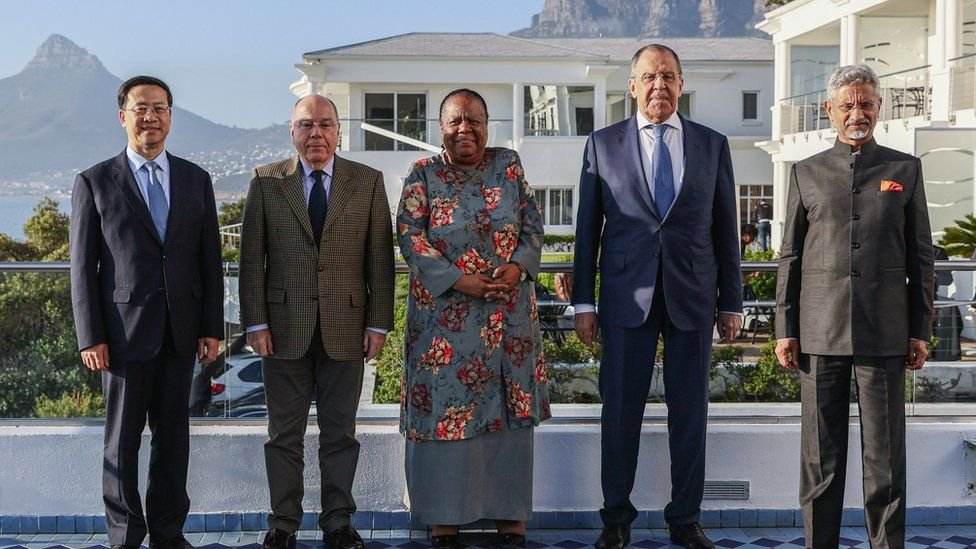Why in News?
- The External Affairs Minister of India S Jaishankar is in Cape Town (South Africa) to attend a meeting of the foreign ministers (FM) of BRICS – a grouping comprising Brazil, Russia, India, China and South Africa.
- The FMs’ meeting will finalise the agenda for the 15th BRICS (South Africa) scheduled with the theme: “BRICS and Africa: Partnership for Mutually Accelerated Growth, Sustainable Development, and Inclusive Multilateralism”.
What’s in Today’s Article?
- About BRICS
- Significance of BRICS
- Economic Cooperation among BRICS
- What’s on the Agenda of 15th BRICS Summit?
- Looking for Multipolarity – Expanding the Membership of BRICS
- Common Currency
- China and India in BRICS
About BRICS:
- Origin:
- The BRIC [Brazil, Russia, India and China] idea was first conceived in 2001 by Goldman Sachs as part of an economic modelling exercise to forecast global economic trends over the next half century.
- In 2006, the group was formalised as BRIC during the 1st BRIC FMs’ meeting on the sidelines of the General Debate of the UN Assembly in New York City.
- After a series of high-level meetings, the 1st BRIC summit was held in Yekaterinburg, Russia in 2009.
- Expansion of BRIC to BRICS:
- BRIC FMs at their meeting in New York in 2010 agreed that South Africa may be invited to join BRIC.
- Accordingly, South Africa was invited to attend the 3rd BRICS Summit in Sanya (China) in 2011.
- BRIC(S) Summits: Since 2009, the head of governments of the BRICS states have met annually at formal summits.
Significance of BRICS:
- BRICS is an important grouping bringing together the major emerging economies from the world, comprising
- 41% of the world population,
- 24% of the world GDP and
- Over 16% share in world trade.
- BRICS countries have been the main engines of global economic growth and have come together to deliberate on three pillars of
- Political and security,
- Economic and financial and
- Cultural and people to people exchanges.
Economic Cooperation among BRICS:
- New Development Bank (NDB): During the 6th BRICS Summit in Fortaleza (Brazil) in 2014, the leaders signed the agreement establishing the NDB.
- It is a multilateral development bank (headquartered in Shanghai, China) operated by the five BRICS states.
- NDB has committed $32.8 billion in 96 socio-economic development projects so far.
- The Contingent Reserve Arrangement (CRA): In 2014, the BRICS governments had signed a treaty, which aimed at forestalling short-term balance of payments pressures and strengthening financial stability of the BRICS nations.
What’s on the Agenda of 15th BRICS Summit?
- Two items on the agenda are attracting attention for their potential for a greater geopolitical consolidation of the grouping:
- A plan to expand the membership of BRICS, and
- A common currency.
Looking for Multipolarity – Expanding the Membership of BRICS:
- As many as 19 countries (such as Argentina, Mexico from Latin America; Nigeria, Algeria, from Africa; Saudi Arabia, UAE, from West Asia; Kazakhstan from Central Asia; Bangladesh and Afghanistan from South Asia; etc) are in the queue to join BRICS.
- The rush towards BRICS is driven by two basic impulses:
- There is considerable anti-US sentiment in the world, and all these countries are looking for a grouping where they can use that sentiment to gather together.
- There is a lot of appetite for multipolarity, for a platform where countries of the Global South can express their solidarity.
Common Currency:
- The idea of a common currency was proposed by Russia’s President at the Beijing BRICS summit last year.
- An insulation from the dollar is a tempting proposal, but not all members believe that it is an idea whose time has come.
- An option is for members to trade with each other in their respective currencies. The India-Russia example has shown, this is not easy either.
China and India in BRICS:
- The war in Ukraine has brought the West together on the one hand and strengthened the China-Russia partnership on the other.
- China is driving the expansion of the BRICS to challenge US hegemony with multilateralism.
- While India’s presence at the G7 summit in Hiroshima and an informal Quad summit was seen as a sign of New Delhi’s US tilt, it attaches significant importance to the BRICS and Shanghai Cooperation Organisation (SCO).
- India called on BRICS nations to demonstrate their sincerity in reforming multilateral institutions, including that of the UN Security Council.
- However, one view on the expanding membership is that it could sideline India’s role in the group




